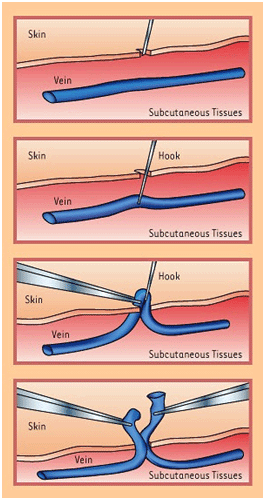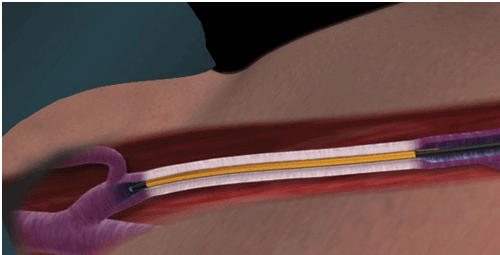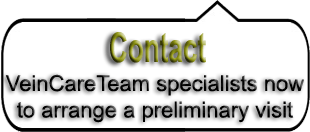Information about chronic venous disease (CVD)
What is chronic venous disease?
If the valves within the veins of the lower limbs fail to work properly, blood can flow backwards in the
veins towards the feet, resulting in pooled blood, which in turn can lead to swelling of the legs and associated
symptoms. Reflux (blood flowing backwards) can occur in the superficial veins (saphenous veins and their tributaries)
or the deep veins.
Symptoms:
Cramp, fatigue, leg heaviness, itchiness, swelling.
Manifestations:
Tortuous and dilated venous walls, changes in skin pigmentation and consistency,
eczema, ulcers.
Incidence of chronic venous disease
Chronic venous insufficiency represents one of the biggest strains on the national health services of European and North American countries. Through the manifestation of varicose syndrome, chronic venous disease affects 35% of the adult white population in Europe and North America, with this percentage increasing with age. 40% of women over the age of 50 suffer from a form of chronic venous disease. More working hours are lost as a result of venous disorders than arterial disease. The key to limiting the social and economic impact of the disease in a population that is living longer is prevention, the correct treatment of the condition and the management of complications by following the established guidelines.
Who could be affected by chronic venous disease?
There are some non-modifiable risk factors:
1 - CVD is a hereditary condition
(the risk increases substantially if one or both parents suffer with CVD).
2 - The risk of CVD increases
with age.
3 - Gender (varices are three-times more common in women).
4 - Pregnancy (the higher the number of pregnancies => the greater the likelihood of developing CVD).
But fortunately there are some modifiable risk factors:
1 - Obesity.
2 - Sedentary lifestyle: it has been proven that sedentary work involving very little exercise leads
to a greater risk of developing CVD.
3 - Smoking.
Common chronic venous disease manifestations
1- capillary (telangiectasias): very common, especially in women. 85% of cases are
symptomatic and may be associated with further venous disease.
2 - reticular veins:
dilated, bluish-green veins that may be associated with significant symptoms in certain areas
of the leg.
3 - varicose veins (varices): they could be located either on the thigh or the lower
leg and may be associated with significant symptoms depending on whether the condition affects the great
or small saphenous vein. 20% of varicose vein patients may develop an ulcer.
4 - changes in skin pigmentation: affecting the lower part of the leg, above or on the ankle, caused
by prolonged venous disease in that area.
5 - ulcers: 50% of cases caused by superficial venous disease and 10% of cases due to prior deep vein thrombosis.
Phlebology
Phlebology is the branch of medicine concerned with the veins, their treatment, correct diagnosis and prevention.
Treatment of chronic venous disease
The following rough guide (which should in no way substitute consulting your GP or a specialist) details the best medical and surgical treatments for chronic venous disease and their complications.
1 - Compression stockings (elastic compression therapy)
Compression stockings create negative
ressure which reduces venous reflux and blood pooling in the legs. They are very effective against symptoms and prevent blood clots from forming in the superficial veins. They are also the maintenance therapy of choice once venous ulcers have healed. Today, compression stockings are available in a wide variety of materials, sizes, colours and styles. These are NOT antithrombotic stockings! Antithrombotic stockings are worn when unable to walk or when bedridden (after surgery that prevents walking or when walking is contraindicated). Furthermore, they cannot guarantee sufficient compression in ambulatory patients. That is why postoperative stockings used in phlebology are elastic stockings, as they need to provide support and facilitate walking and normal daily activities.
Which stockings should I choose:
- mild symptoms including fatigue, slight swelling: 14 mmHg
- more severe symptoms, including cramp, swelling: 18 mmHg
- varicose veins, pain: Class I
- for post-ulcer and lymphoedema: Class II
Stockings must be measured to ensure that they can be worn comfortably:
there are tables and specialist shops to assist in making the right choice. There is also equipment available
to facilitate putting the stockings on in the event that the patient has difficulty reaching his/her leg (for example,
for severe arthritis that inhibits movement).
2 - Exercise and physical activity
- Significantly improves symptoms.
- Reduces the appearance or reappearance of venous ulcers.
- Leads to quicker recovery from phlebitis and deep thrombosis.
- At least 30 minutes of activity a day.
- Which activities: walking, swimming, running etc. Do not lift heavy weights as this could exacerbate varicose veins.
3 - When should I arrange a consultation with a specialist to surgically treat varicose veins?
- When symptoms do not respond to conservative therapy.
- When compression stockings cannot be tolerated.
- When an aesthetic improvement is required or preferable.
- When the ankles exhibit changes in pigmentation or new characteristics, which may suggest a worsening
of chronic venous disease.
- When spontaneous bleeding or ulcers occur.
4 - Modern surgical treatment for chronic venous disease
Points to note: Many patients present with combinations of capillaries, reticular veins and varicose veins.
That is why the proposed treatment must be tailor-made to suit each individual case.
This means that treatment for the same condition (varices) may differ between patients, depending on
disease presentation and patient requirements and expectations.
That said, the choice of surgical treatment
is not left to one single surgeon or specialist, but rather dictated by the clinical literature
(NICE Guidelines, in force since 2013).
Patients with symptomatic venous disease of the lower limbs should attend a
phlebology surgery department.
After a consultation, comprising patient interview,
clinical examination and colour Doppler ultrasound, surgery is indicated for conditions affecting the saphenous vein, and endovascular treatment should be proposed (Laser, Radiofrequency, Cyanoacrylate glue ablation).
Only in countries in which such a treatment is not available should the procedure be changed to ultrasound-guided sclerosis (by which the vein is closed by injecting a liquid into the vein that destroys the walls). Finally, only if none of these options is available should classic surgery be proposed (stripping).
For capillaries, the treatment of choice is sclerotherapy: it reduces the symptoms, improves the appearance and is repeatable.
For reticular veins, a combination of sclerotherapy and mini-invasive surgery effectively treats the condition in the majority of cases.

Sclerotherapy and mini-invasive surgery
Today, the surgical treatment of choice for varicose veins is endovascular surgery (Laser, Radiofrequency, Cyanoacrylate glue ablation), which boasts the same success rate as traditional surgery but without the side effects. Local anaesthetic and reduced surgical impact allow normal daily activities to be resumed immediately with optimal aesthetic outcomes.

Endovascular surgery











